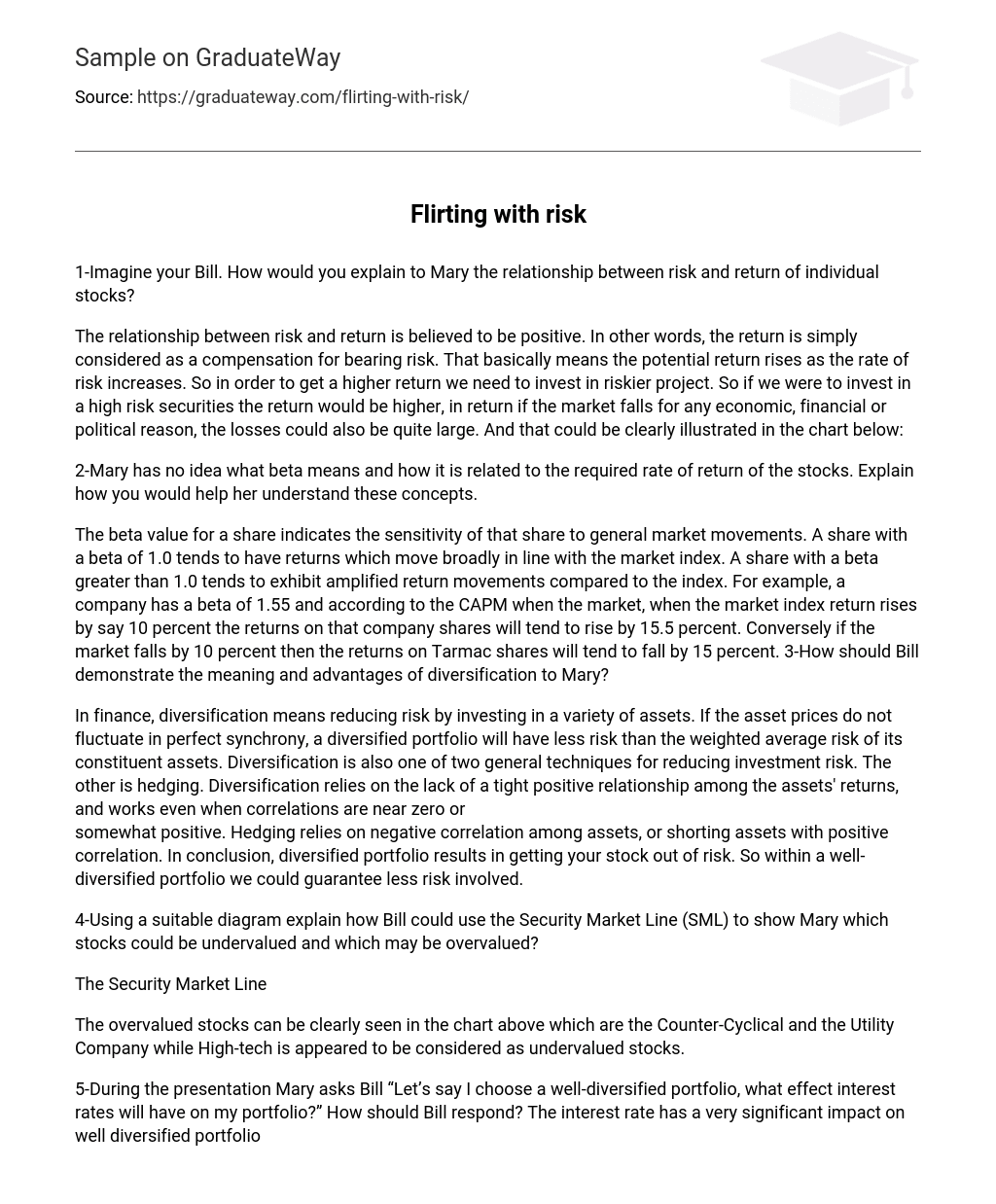1-Imagine your Bill. How would you explain to Mary the relationship between risk and return of individual stocks?
The relationship between risk and return is believed to be positive. In other words, the return is simply considered as a compensation for bearing risk. That basically means the potential return rises as the rate of risk increases. So in order to get a higher return we need to invest in riskier project. So if we were to invest in a high risk securities the return would be higher, in return if the market falls for any economic, financial or political reason, the losses could also be quite large. And that could be clearly illustrated in the chart below:
2-Mary has no idea what beta means and how it is related to the required rate of return of the stocks. Explain how you would help her understand these concepts.
The beta value for a share indicates the sensitivity of that share to general market movements. A share with a beta of 1.0 tends to have returns which move broadly in line with the market index. A share with a beta greater than 1.0 tends to exhibit amplified return movements compared to the index. For example, a company has a beta of 1.55 and according to the CAPM when the market, when the market index return rises by say 10 percent the returns on that company shares will tend to rise by 15.5 percent. Conversely if the market falls by 10 percent then the returns on Tarmac shares will tend to fall by 15 percent. 3-How should Bill demonstrate the meaning and advantages of diversification to Mary?
In finance, diversification means reducing risk by investing in a variety of assets. If the asset prices do not fluctuate in perfect synchrony, a diversified portfolio will have less risk than the weighted average risk of its constituent assets. Diversification is also one of two general techniques for reducing investment risk. The other is hedging. Diversification relies on the lack of a tight positive relationship among the assets’ returns, and works even when correlations are near zero or
somewhat positive. Hedging relies on negative correlation among assets, or shorting assets with positive correlation. In conclusion, diversified portfolio results in getting your stock out of risk. So within a well-diversified portfolio we could guarantee less risk involved.
4-Using a suitable diagram explain how Bill could use the Security Market Line (SML) to show Mary which stocks could be undervalued and which may be overvalued?
The Security Market Line
The overvalued stocks can be clearly seen in the chart above which are the Counter-Cyclical and the Utility Company while High-tech is appeared to be considered as undervalued stocks.
5-During the presentation Mary asks Bill “Let’s say I choose a well-diversified portfolio, what effect interest rates will have on my portfolio?” How should Bill respond? The interest rate has a very significant impact on well diversified portfolio as it helps to measure and calculate the cash flows and the accrual expenses and incomes through a certain period of time.
6-Should Bill take Mary out of investing in stocks and preferably put all her money in fixed-income securities? Explain. Bill should not convince Mary to invest all the money in fixed-income securities as diversifying portfolio is required for the good investment. Moreover, the relationship between risk and return is positive, therefore in order to get a higher return we need to invest in riskier stocks.
7-Mary tells Bill, “I keep hearing stories about how people have made thousands of dollars by following their brokers’ hot tips. Can you give me some hot tips regarding undervalued stocks?” How should Bill respond? There is no guarantee as to when or whether a stock that appears undervalued will appreciate. There is also no single correct way to determine a stock’s intrinsic value – it is basically an educated guessing game.
8-If Marry decided to invest her money equally in high-tech and counter-cyclical stocks, what would her portfolio’s expected return and risk level be? Are these expectation realistic? Please Explain.
If Marry were to invest 50% of her money in High-tech tocks while having the rest invested in counter-cyclical, her portfolio expected return would be -0.85 which does not seem very realistic as it is negative.
9-What would happen if Marry were to put 70% of her portfolio in the High-tech stock and 30%in the index fund? Would this combination be better for her? Explain. If marry decided to invest 70% of her money in the High-tech stock while the rest in the index fund the expected return would be 0.59 which seems preferable to the previous option and it could generate a higher return.
10-Based on this calculation what do you think Bill should propose as a possible portfolio combination for Marry? If I were Bill I would choose the second option showed in question no. 9
References:
Corporate Financial Management by Glen Arnold (4th Ed)
http://www.investopedia.com/terms/u/undervalued.asp#ixzz2HD5n8ZGE http://en.wikipedia.org/wiki/CAPM
http://www.investopedia.com/university/concepts/concepts1.asp





